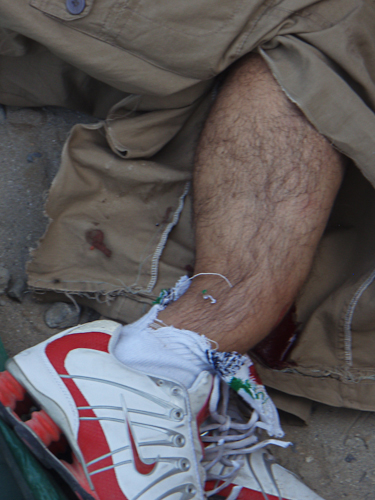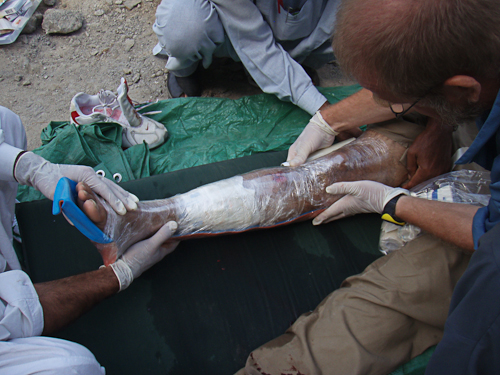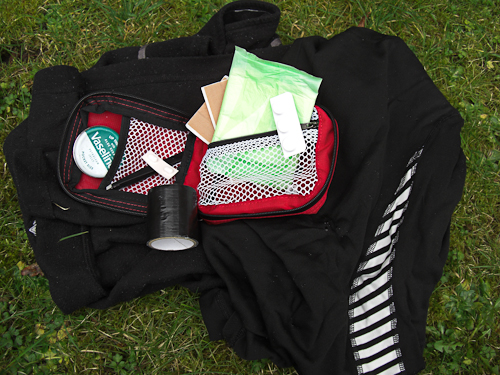Do you carry a first aid kit in the mountains - and do you know how to use it? Dr Steph Mackie takes a look.
Picture the scene. You're four hours into a walk in one of Scotland's remoter hills. You're looking forward to an epic climb, a night spent warming up by the fire in a bothy, then tramping back out the way you came tomorrow. You and your climbing partner are both well-equipped, with plenty of warm clothes, food and a decent first aid kit between you. Without warning, your mate slips on a wet slab of rock and falls awkwardly. His legs are fine, but his wrist and arm hurt and with the blood dripping out of the wound where a sharp stone cut his head there's no way he'll be climbing today.
The nearest road is ten miles away, and you haven't had any mobile phone signal for hours. Think you can remember how that unfamiliar triangular bandage sitting at the bottom of your first aid kit should best be tied to support your friend's arm? And how cold and wet will you both be getting whilst you rummage for a plaster big enough for the cut in his scalp which is still oozing blood?

Tib and Fib fracture: a serious injury

But even for serious injuries like this, simple equipment is often enough to buy time for evacuation.
There are a few excellent ready-made first aid kits on the market in the UK, but the truth is the majority of them contain items which are heavy, bulky and not as straightforward to use as they need to be. The majority of people out climbing, walking, running or biking in the UK's upland regions won't need the kit to carry out field surgery – you just need enough to safely deal with common minor injuries such as cuts, sprains and blisters whilst having the basics to support a more serious casualty until help arrives.
Four different sizes of crepe and triangular bandage, enough antiseptic wipes to sterilise an operating theatre, and a tubigrip are likely to be too much hassle to use for smaller problems. For more serious casualties they are often irrelevant, yet they take up valuable space and weight which would often be better used carrying an extra layer or more food to keep yourself or a casualty warm and well fed if the worst happens.

The essentials of a first aid kit – lightweight and compact
With a bit of thought and planning, it is easy to pack a first aid kit which will provide you with the equipment you need to deal with most situations for a fraction of the cost, size and weight of many commercially-available kits. Many items can be used for more than one purpose, and a number of situations can be dealt with by improvising with items you would normally carry in your pack anyway.
Minor injuries are fairly common in the hills. It is a rare person who has never had a blister, cut or sprain, and although not serious many minor injuries can make your day miserable. They are often easily treated though, and it's worth considering carrying a few things to deal with often-seen problems:
-
A tiny pot of vaseline stops chafing before it causes problems and is ideal to prevent blisters from worsening after they have been dressed.
-
Elastoplast tape can be cut to size to cover small to medium cuts and scratches without having to carry lots of different sizes of plasters.
-
A pair of tweezers is useful for pulling out thorns and insect stings.
-
Antihistamine tablets are tiny and cutting one or two out of a blister pack can be useful for itchy insect bites or minor allergic reactions.
-
A couple of over-the-counter painkiller tablets (paracetamol and/or ibuprofen) will help you deal with any aches or minor sprains before they become a major problem.
Although more serious injuries don't happen nearly as often as the above cuts and scrapes, there are a few things which can help to look after a “walking wounded” casualty whilst you help them get back to safety:
-
Wounds which are bleeding a fair bit need dressings to protect them and absorb blood. Field dressings will do this but are expensive, heavy, and can only be used in a limited number of situations. Sanitary towels are a cheap, light and easily available substitute, though you might not look like much of a hardcore tough guy with one stuck to your oozing head wound.
-
Duct tape can be used to hold dressings in place, secure makeshift splints, and for many other purposes – it will stick to anything and is waterproof to keep blood in and germs out.
-
Particularly when climbing there may be a risk of eye injury. Small pods of sterile water or saline can be bought from most pharmacies and these are useful for washing bits of grit or chemicals out of the eye; they can also be used to wash out wounds.
Triangular bandages to support injured arms are often found in first aid kits. They do work, but are a bit of a hassle to tie and again aren't much use for any other purpose. It's easy enough to tie an extra base layer or jacket into a makeshift sling which will support an arm perfectly well.
First aid training
Although rare, sometimes more serious incidents involving people with serious injuries or illnesses do happen. Usually these people will not be able to walk back to safety and the main priority in the UK will be to keep them as safe, warm and stable as possible until help arrives. Undoubtedly the most useful thing to have in these situations is training in first aid and basic life support.
If you have never learned these skills, or were taught them many years ago, seriously consider taking a course such as those taught by Rescue Emergency care or Wilderness Medical Training. You do not need to be an experienced doctor or nurse to carry out some of the basic procedures which will hugely improve the chances of a very sick patient before the emergency services can reach you – simple things like learning how to keep an unconscious person's airway open can mean the difference between life and death.

Assessing an injured climber: basic airway skills are crucial.
Summoning help
If you do need help from mountain rescue or other emergency services, there are two things to consider – how will you attract attention; and what do you need to tell them? Many of us carry mobile phones on the hill, but these are never foolproof and problems with reception and battery life are often an issue in upland areas. 6 blasts on a whistle, or 6 flashes of a torch or mirror, are useful alternative ways of attracting attention. In some areas it may be quicker to send another member (or ideally two) of the group to the nearest house or farm to get help.
When you do manage to get in touch with the emergency services, they will be able to get appropriate help to you if they know a few key pieces of information:
-
Where are you? Give a grid reference, and mention nearby landmarks.
-
Who is affected? How many people, ages, and names if you know them.
-
What has happened? Nature of the accident or problem, what injuries are involved.
-
How unwell are any casualties? Conscious level, and measurements of pulse if you are confident taking it are often useful.
-
How will the emergency services get in touch with you? Your mobile phone number and that of any others in the group, radio channels if you are carrying them.
If you don't have any prior training, or you're a bit rusty, it might boost your confidence to have a small laminated card with emergency instructions in your first aid kit. The BMC have also published a sample accident report form which can be printed onto waterproof paper and kept in your first aid kit, available at . An emergency might not seem like the time to be filling in paperwork but in a stressful, unfamiliar situation it often helps to gather your thoughts, ensuring that you can give the emergency services all the information they need.
Other than that there is relatively little equipment which is worth carrying. Spare clothes can be used to keep casualties warm, tie on pressure dressings, protect injured areas from pressure and knocks. Ice axes or walking poles can be used as makeshift splints for broken arms or legs. A number of these strategies were used by Rob Latimer at the 2010 Lowe Alpine Mountain Marathon after his team-mate Martin Potter was involved in a serious fall in Glen Fyne – Rob was unable to find a first aid kit and his improvisation with clothes which they had carried with them kept Martin safe and warm until help arrived.
Everyone has experience and skills in the hills, and what you carry in a first aid kit will depend on what your activities; training; and group size; but hopefully the suggestions above will be a good starting point. Confidence in basic first aid and life support are things which you can take with you and don't add any size or weight to your pack: if you could do with more training consider contacting the organisations below for information on courses.
First aid training is available from:
Rescue Emergency Care Courses
Wilderness Medical Training
St John Ambulance
St Andrew's First Aid
« Back